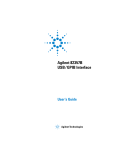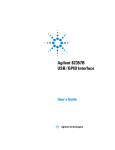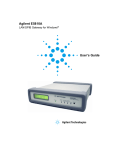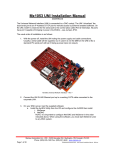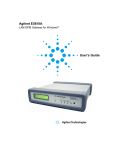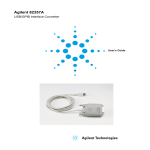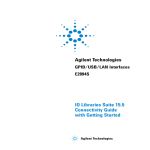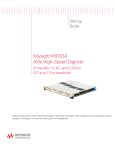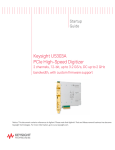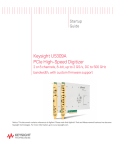Download Agilent Technologies 6632B Power Supply User Manual
Transcript
Agilent 82350B
PCI GPIB
Interface
Installation and
Configuration
Guide
Agilent Technologies
Notices
© Agilent Technologies, Inc. 2002 - 2009
No part of this manual may be reproduced
in any form or by any means (including
electronic storage and retrieval or
translation into a foreign language)
without prior agreement and written
consent from Agilent Technologies, Inc. as
governed by United States and
international copyright laws.
Manual Part Number
82350-90004
Edition
Eighth Edition, July 20, 2009
Printed in Malaysia
Agilent Technologies, Inc.
3501 Stevens Creek Blvd.
Santa Clara, CA 95052 USA
Microsoft is a U.S. registered trademark of
Microsoft Corporation.
“PCI-SIG” and the PCI SIG design marks
are registered trademarks and/or service
marks of PCI-SIG.
FireWire is a registered trademark of Apple
Computer, Inc.
Warranty
The material contained in this document
is provided “as is,” and is subject to
being changed, without notice, in future
editions. Further, to the maximum extent
permitted by applicable law, Agilent disclaims all warranties, either express or
implied, with regard to this manual and
any information contained herein, including but not limited to the implied warranties of merchantability and fitness for a
particular purpose. Agilent shall not be
liable for errors or for incidental or consequential damages in connection with
the furnishing, use, or performance of this
document or of any information contained
herein. Should Agilent and the user have
a separate written agreement with warranty terms covering the material in this
document that conflict with these terms,
the warranty terms in the separate agreement shall control.
Technology Licenses
The hardware and/or software described
in this document are furnished under a
license and may be used or copied only in
accordance with the terms of such license.
Restricted Rights Legend
U.S. Government Restricted Rights. Software and technical data rights granted to
the federal government include only those
rights customarily provided to end user
customers. Agilent provides this customary commercial license in Software and
technical data pursuant to FAR 12.211
(Technical Data) and 12.212 (Computer
Software) and, for the Department of
Defense, DFARS 252.227-7015 (Technical
Data - Commercial Items) and DFARS
227.7202-3 (Rights in Commercial Computer Software or Computer Software Documentation).
ii
Safety Notices
CAU TI O N
WA RN ING
A CAUTION notice denotes a hazard. It calls attention to an
operating procedure, practice, or the like that, if not
correctly performed or adhered to, could result in damage to
the product or loss of important data. Do not proceed beyond a
CAUTION notice until the indicated conditions are fully understood and met.
A WARNING notice denotes a hazard. It calls attention to an
operating procedure, practice, or the like that, if not correctly
performed or adhered to, could result in personal injury or
death. Do not proceed beyond a WARNING notice until the
indicated conditions are fully understood and met.
iii
Safety Symbols
The following symbol on the instrument and in the documentation indicates precautions that must be taken to maintain safe
operation of the instrument.
Direct current
Alternating current
Both direct and alternating current
Three-phase alternating current
Earth (ground) terminal
Protective conductor terminal
Frame or chassis terminal
Equipotentiality
Equipment protected throughout by double insulation
or reinforced insulation
Caution, risk of electric shock
iv
Caution, risk of danger (refer to this manual for specific
Warning or Caustion information.
Caution, hot surface
v
General Safety Information
CAU TI O N
WA RN ING
• Use the device with the cables provided.
• Repair or service that is not covered in this manual should
only be performed by qualified personnels.
• Do not use the device if it appears damaged or defective.
• Observe all markings on the device before connecting any
wiring to the device.
• Do no operate the device in the presence of flammable
gases or fumes.
• Do no install substitute parts or perform any unauthorized
modification to the device.
vi
Environment Conditions
This instrument is designed for indoor use in areas with low
condensation. Table 1 shows the general environment
requirements.
Table 1 Environment requirements
Environment Conditions
Requirements
Operating environment
0 °C to +55 °C
Operating himidity
Up to 90% at 40 °C non-condensing
Storage environment
– 40 °C to +70 °C
Storage humidity
Up to 90% at 65 °C non-condensing
CAU TI O N
The Agilent 82350B PCI GPIB Interface complies with the
following safety and EMC requirements:
IEC 61326-1
Group 1, Class A
IEC 61010-1
vii
Regulatory Markings
The CE mark is a registered trademark of the European Community. The CE mark shows that the product complies with all the relevant European Legal
Directives.
ICES/NMB-001 indicates that this ISM device
complies with Canadian ICES-001.
The CSA mark is a registered trademark of the
Canadian Standards Association. A CSA mark with
the indicators “C” and “US” means that the product
is certified for both the U.S. and Canadian markets,
to the applicable American and Canadian
standards.
The C-tick mark is a registered trademark of the
Spectrum Management Agency of Australia. This
signifies compliance with the Australia EMC Framework regulations under the terms of the Radio Communication Act of 1992.
This product complies with the WEEE Directive
(2002/96/EC) marking requirement. The affixed
product label indicates that you must not discard
this electrical/electronic product in domestic
household waste.
viii
Waste Electrical and Electronic Equipment
(WEEE) Directive 2002/96/EC
This instrument complies with the WEEE Directive
(2002/96/EC) marking requirement. This affixed product label
indicates that you must not discard this electrical/electronic
product in domestic household waste.
Product Category:
With reference to the equipment types in the WEEE directive
Annex 1, this instrument is classified as a “Monitoring and
Control Instrument” product.
The affixed product label is shown as below:
Do not dispose in domestic household waste
To return this unwanted instrument, contact your nearest Agilent office, or visit:
www.agilent.com/environment/product
for more information.
ix
DECLARATION OF CONFORMITY
According to ISO/IEC Guide 22 and CEN/CENELEC EN 45014
Manufacturer’s Name:
Manufacturer’s Address:
Agilent Technologies, Incorporated
815 – 14th St. SW
Loveland, CO 80537
USA
Declares under sole responsibility that the product as originally delivered
PCI GPIB Interface
82350B
This declaration covers all options of the above product(s)
Product Name:
Model Number:
Product Options:
complies with the essential requirements of the following applicable European Directives, and
carries the CE marking accordingly:
EMC Directive (89/336/EEC, amended by 93/68/EEC)
Low Voltage Directive (73/23/EEC, amended by 93/68/EEC)
and conforms with the following product standards:
EMC
Standard
Limit
IEC 61326-1:1997+A1:1998 / EN 61326-1:1997+A1:1998
CISPR 11:1990 / EN 55011:1991
IEC 61000-4-2:1995+A1:1998 / EN 61000-4-2:1995
IEC 61000-4-3:1995 / EN 61000-4-3:1995
IEC 61000-4-4:1995 / EN 61000-4-4:1995
IEC 61000-4-6:1996 / EN 61000-4-6:1996
Group 1 Class A
4 kV CD, 8 kV AD
3 V/m, 80-1000 MHz
0.5 kV signal lines, 1 kV power lines
3 V, 0.15-80 MHz 1 cycle, 100%
Canada: ICES-001:1998
Australia/New Zealand: AS/NZS 2064.1
The product was tested in a typical configuration with Agilent Technologies test systems.
IEC 61010-1:2001 / EN 61010-1:2001
Canada: CSA C22.2 No. 1010.1:1992
UL 61010B-1: 2003
Safety
Supplementary Information:
This DoC applies to above-listed products placed on the EU market after:
20 April 2004
Date
Ray Corson
Product Regulations Program Manager
For further information, please contact your local Agilent Technologies sales office, agent or distributor,
or Agilent Technologies Deutschland GmbH, Herrenberger Straße 130, D 71034 Böblingen, Germany.
Template: A5971-5302-2, Rev. B.00
x
82350B-DoC-B
DoC Revision B
Contents
1
Installing and Configuring the 82350
Getting Started 2
Step 1 - Before you install the 82350 3
Check your shipment 3
System requirements 4
Create an emergency repair disk 6
Step 2: Installing the Agilent IO Libraries Suite 7
Checking for installed Agilent IO Libraries 7
Installing Agilent IO Libraries Suite 9
Step 3: Connecting your instruments 17
Installing the 82350 in your PC 17
Connecting instruments to the 82350 19
Step 4: Configuring the 82350 23
Installing configuration files 23
Configuring the 82350 interface 24
Step 5: Communicating with your instruments 28
Verifying instrument communication 28
Programming your instruments 29
2
Troubleshooting Guidelines
Troubleshooting Overview 34
82350 Hardware Checks 35
Check cables/connections/power 35
82350 Software Checks 40
Agilent IO Libraries Suite Checks 45
Check IO Libraries Suite installation 45
Check IO Control operation 46
Install IO Libraries Suite (if 82350 was installed first) 47
xi
3
82350 Specifications and Information
General Requirements 50
General Characteristics 51
Accessing an Electronic Copy of this Guide 52
Contacting Agilent 53
xii
Agilent 82350B PCI GPIB Interface 82350B PCI
GPIB Interface
Installation and Configuration Guide
1
Installing and Configuring
the 82350
This Agilent 82350B PCI GPIB Interface Installation and
Configuration Guide shows you how to install and configure
the Agilent 82350B PCI GPIB Interface (called the 82350 in this
guide) and shows how to use the Agilent IO Libraries Suite to
configure the card in PCs with Windows XP or Windows Vista
or Windows 7 operating systems.
NO TE
The 82350 interface is supported on PCs with Windows NT®
4.0, but the latest version of Agilent IO Libraries Suite is not
supported on NT. To use Windows NT, go to
http://www.agilent.com/find/iolib and download Agilent IO
Libraries M.01.01. Refer to the IO Libraries M.01.01
documentation for installation and configuration instructions.
In case of difficulty in installing the 82350, see Chapter 2 Troubleshooting Information.
Agilent Technologies
1
1
Installing and Configuring the 82350
Getting Started
In this guide, an 82350 GPIB Interface System is
defined as a system in which GPIB instruments are
connected via GPIB cables to an 82350 PCI GPIB
Interface Card (called the 82350 in this guide) that
is installed in a Windows PC. Figure 1- 1 shows a
typical system.
GPIB Cable
Instrument
PC
Connect to 82350 GPIB
Interface Card installed in PC.
Instrument
Connect to GPIB
port on instrument.
Figure 1-1 82350B system overview
Use the following sequence of steps as a guide as
you set up your GPIB system. See the associated
steps if you need more details. See Chapter 2 Troubleshooting Guidelines if you need additional
information on setting up the 82350 or GPIB
instruments.
2
82350B Installation and Configuration Guide
Installing and Configuring the 82350
1
Step 1 - Before you install the 82350
Before you install the 82350, you should:
• Check Your Shipment
• Check System Requirements
• Create an Emergency Repair Disk
Check your shipment
Your 82350 Interface shipment should include the
items in Figure 1- 2. If any items are missing or
damaged, keep the shipping materials and contact
Agilent Technologies. See Chapter 3 - 82350 Guide
Information for addresses/telephone numbers.
CAU TI O N
To reduce the risk of damaging the 82350B card, protect
the card from static electricity. Leave the card in its
anti-static bag until you are ready to install the card.
Handle the card only by the sheet metal frame or by the
card edges. Never touch any other part of the card.
Agilent Technologies 82350B PCI GPIB Interface Card
Agilent IO Libraries for Instrument Control CD
82350B Getting Started Poster
82350B PCI GPIB Installation and Configuration Guide
82350B Warranty Statement
Software License Agreement
82350B Poster
82350B Guide
Warranty
Statement
82350B PCI GPIB Interface Card
Agilent AutomationReady CD
Software License
Figure 1-2 82350B shipment contents
82350B Installation and Configuration Guide
3
1
Installing and Configuring the 82350
System requirements
The following is a list of the system configurations
that we tested IO Libraries 15.5 on and are therefore guaranteed to work. In general, any x86 or
x64 (except Itanium) should work but there may be
a decrease in performance.
Windows XP Service Pack 3 (or later)
Processor Speed:
600 MHz or higher required, 800 MHz
recommended
Available memory:
256 MB minimum (1 GB or greater recommended)
Available hard disk space1:
1.5 GB available hard disk space, includes:
• 1GB available for Microsoft .NET Framework 2.0
• 65MB for Agilent IO Libraries Suite
Video:
Super VGA (800x600) 256 colors or more
Browser:
Microsoft Internet Explorer 5.01 or greater
1 Because of the installation procedure, less memory may be
required for operation than is required for installation.
4
82350B Installation and Configuration Guide
Installing and Configuring the 82350
1
Windows VISTA SP1 and SP2 (32-bit and 64-bit),
Business, Ultimate, Enterprise, Home Basic, and
Home Premium
Processor Speed:
1Ghz 32- bit (x86), 1GHz 64- bit (x64), no support
for Itanium64
Available memory:
1 GB minimum
Available hard disk space1:
1.5 GB available hard disk space, includes:
• 1GB available for Microsoft .NET Framework 2.0
• 65MB for Agilent IO Libraries Suite
Video:
Support for DirectX 9 graphics with 128MB
graphics memory recommended (Super VGA
graphics is supported)
Browser:
Microsoft Internet Explorer 7 or greater
Windows 7 (32- and 64-bit), Home Basic, Home
Premium, Professional, Ultimate, Enterprise
Processor Speed:
1Ghz 32- bit (x86), 1GHz 64- bit (x64), no support
for Itanium64
Available memory:
1 GB minimum
Available hard disk space1:
1.5 GB available hard disk space, includes:
• 1GB available for Microsoft .NET Framework 2.0
• 65MB for Agilent IO Libraries Suite
82350B Installation and Configuration Guide
5
1
Installing and Configuring the 82350
Video:
Support for DirectX 9 graphics with 128MB
graphics memory recommended (Super VGA
graphics is supported)
Browser:
Microsoft Internet Explorer 7 or greater
Create an emergency repair disk
The Agilent IO Libraries Suite includes I/O drivers
for various PCI plug- in cards. Extensive testing of
these drivers and cards has revealed that early
revisions of the BIOS code in several PCs are not
completely PCI- compliant. This has caused
problems when running the Agilent IO Libraries,
whether or not the PCI card is installed. Problems
can include system errors, operating system
crashes, or card initialization failures.
For Windows NT operating systems, most PC
manufacturers recommend that before installing
any PCI card, you first create an EMERGENCY
REPAIR DISK. If your PC exhibits any abnormal
behavior following installation of the Agilent IO
Libraries, we recommend a BIOS upgrade to
the PC. BIOS upgrades are available from most PC
manufacturers’ websites.
6
82350B Installation and Configuration Guide
Installing and Configuring the 82350
1
Step 2: Installing the Agilent IO Libraries Suite
Below are the steps on how to install the Agilent
IO Libraries Suite, using default settings, including:
• Checking for Installed Agilent IO Libraries or
Agilent IO Libraries Suite
• Installing Agilent IO Libraries Suite
NO TE
See the Agilent IO Libraries Getting Started Guide on your
Automation-Ready CD for a full description of installation
options and installation troubleshooting information.
You must have Administrator privileges to install the IO
Libraries Suite and to run the Connection Expert utility.
Checking for installed Agilent IO Libraries
Before you begin installation, check for previously
installed Agilent IO Libraries software. If a version
of the Agilent IO Libraries Suite is installed on
your PC, a blue IO icon may be displayed on the
Windows Notification Area (on the lower
right- hand side of the screen).
IO Libraries Suite icon
Figure 1-3 IO Libraries Suite icon
• If the IO icon is displayed, click the icon and
click About Agilent IO Control to display the
version. The version must be 15.0 and above. If
the IO icon is not displayed, a version may still
be installed. To check this, click Start |
Programs and look for the Agilent IO Libraries
or Agilent IO Libraries Suite program group.
82350B Installation and Configuration Guide
7
1
Installing and Configuring the 82350
• If this group is displayed, click Agilent IO
Libraries > Utilities > IO Control to display the
IO icon. Then, click the icon and click About
Agilent IO Libraries Control to display the
installed version (must be 15.0 or greater).
• If neither the IO icon nor the Agilent IO
Libraries program group is displayed, no Agilent
IO Libraries are installed and you can use
the steps in this chapter and in the Agilent IO
Libraries Suite Connectivity Guide to install the
libraries.
• If the version of the Agilent IO Libraries Suite is
less than 15.0, you must install the latest version
included on your Automation- Ready CD to
support the 82350B.
• If possible, you should always use the current
version of the Agilent IO Libraries Suite. This
version supports the latest interfaces and
operating systems and has the most advanced
features.
8
82350B Installation and Configuration Guide
Installing and Configuring the 82350
1
Installing Agilent IO Libraries Suite
NO TE
NO TE
You must have Administrator privileges to install Agilent IO
Libraries Suite Connection Expert.
Every IO Libraries Suite installation is a “Full installation”
In past versions of IO Libraries, there was an option to install
IO Libraries as either a Full version or a Runtime version.
Beginning with IO Libraries Suite 14.0, the installation process
provides a Full installation for all users (i.e. there is no longer
a Runtime installation option). This means that every installation now includes the development components of the Agilent
IO Libraries Suite software, which allow you to develop your
own I/O programs. If you wish to minimize the size of the
installed software, select a Custom installation; when you get
to the Select Features dialog, do not select the manuals and
the sample programs.
This section describes how to install Agilent IO
Libraries Suite on your PC. The process is as
follows:
1 Verify that your PC meets the minimum system
requirements. (See “System Requirements for
Agilent IO Libraries Suite 15.5” in the IO Libraries Suite 15.5 Connectivity Guide)
2 If you are upgrading to IO Libraries Suite from a
previous version of IO Libraries, you must
remove the instruments and interfaces listed
below before you upgrade your software. This
step is necessary in order for these devices to
obtain the correct drivers to work with Agilent
IO Libraries Suite.
a Disconnect any USB instruments from your
PC.
b Disconnect any Agilent 82357 USB/GPIB interface converters from your PC.
c Disconnect any Agilent E8491 IEEE 1394 PC
Link to VXI interfaces from your PC.
82350B Installation and Configuration Guide
9
1
Installing and Configuring the 82350
3 Close all other applications on your PC.
NO TE
NO TE
If you install a PCI card in your computer at the same time you
install Agilent IO Libraries Suite 15, a possible conflict can
occur. The “New Hardware Found” dialog for the PCI card
must be closed before installing IO Libraries. Otherwise the IO
Libraries installation will stop until PCI card installation is complete.
If you have NI software installed (such as NI MAX, etc.), then
all NI services must be stopped prior to installing IO Libraries.
4 Insert the Automation- Ready CD with Agilent IO
Libraries Suite into the CD- ROM drive of your
PC.
• Wait a few seconds for the auto- run window to
appear.
• If the auto- run window does not appear automatically,
• Click Start > Run...
• Type <drive>:autorun\auto.exe, where
<drive> is your CD drive letter.
5 When the installation start- up window appears,
click the “Click here to install now” button
once, and wait for the InstallShield Wizard to
appear.
Note: you also have the opportunity to watch a
two- minute video how easy it is to install,
set- up and configure your interfaces and instruments using Agilent IO Libraries Suite 15.
6 If the IVI Shared Components and IVI VISA
COM Standard Components are not already
installed on your PC, Agilent IO Libraries Suite
installs them in the standard, default locations.
10
82350B Installation and Configuration Guide
Installing and Configuring the 82350
NO TE
1
The IVI Shared Components and IVI VISA COM Standard Components are installed in default folders. However, if you need to
install the IVI Components in a unique location refer to “Custom Installation of IVI Shared Components” in the IO Libraries
Suite 15.5 Connectivity Guide.
7 When the InstallShield Wizard appears, click
Next > to begin the IO Libraries Suite software
installation.
8 Read the License Agreement(s). If you accept the
terms, click the radio button labeled I accept
the terms of the license agreement and then
click Next > to continue.
9 When the InstallShield Wizard Setup Type dialog
box appears, as shown, select Typical or Custom, then click OK. The Typical setup installs
the recommended features for your configuration
in standard locations on your PC. In a Typical
setup, if another vendor’s VISA software is
already installed on this PC, Agilent VISA is
installed as secondary. If no other vendor’s VISA
software is found on this PC, Agilent VISA is
installed as primary. (See “Using Agilent VISA in
Side- by- Side Mode” in the IO Libraries Suite 15.5
Connectivity Guide.)
82350B Installation and Configuration Guide
11
1
Installing and Configuring the 82350
NO TE
• If you accept the Typical Installation, click “Next” and proceed to Step 13, Start Copying Files, on page 14.
• If you chose the Custom Installation radio button, click
“Next” and proceed with Step 10 below.
10 If you chose the Custom setup and you do not
have another vendor’s VISA implementation
installed on your PC, then you will see the dialog box below, which asks whether you want to
install Agilent VISA as the primary VISA.
12
82350B Installation and Configuration Guide
Installing and Configuring the 82350
1
If you do have another vendor’s VISA installed,
you will see a similar dialog box, but the check
box will not be selected, indicating that the
default is to install Agilent VISA as secondary.
For details on this topic, see “Using Agilent
VISA in Side- by- Side Mode” in the IO Libraries
Suite 15.5 Connectivity Guide.
11 If you chose a Custom setup, the next dialog
shows the location of:
• The IO Libraries Suite Destination Folder
• Agilent VISA Destination Folder
• IVI Components Destination Folder
The VISA and IVI destinations are greyed out.
They are for information only. In order to
change them you must follow the instructions in
“Custom Install the IVI Shared Components” in
the IO Libraries Suite 15.5 Connectivity Guide.
12 If you chose a Custom setup, you will now see
the Select Features dialog box.
82350B Installation and Configuration Guide
13
1
Installing and Configuring the 82350
• Click on any feature in the list to see the feature description and the space requirements
for the selected set of features. It is recommended that you install the manuals and sample programs if you plan to program with the
Agilent IO Libraries; however, you may omit
them to save space.
• Select the check box for each feature to be
installed. Clear the check box for each feature
to omit.
• When you are done selecting features, click
Next >.
13 The Start Copying Files dialog appears; click
Install to begin copying files.
• If the Microsoft .NET Framework version 2.0 has
not previously been installed on your PC, IO
Libraries will install them; this may take up to
ten minutes. The Microsoft .NET Framework provides necessary infrastructure for Agilent IO
Libraries Suite utilities, as well as for .NET programming tools and many other applications. You
will only need to install the .NET Framework
once, even if you remove and reinstall or
upgrade your IO Libraries Suite.
14
82350B Installation and Configuration Guide
Installing and Configuring the 82350
1
14 After the files have been copied, you may see a
dialog asking you to restart your PC. This occurs
only if you have certain I/O hardware configurations. If you choose not to reboot at this time,
you should reboot before running Connection
Expert.
15 When the InstallShield Wizard Complete dialog
appears indicating that Agilent IO Libraries was
successfully installed:
a Click Finish to close the window
b Or click on one of the product/solution links
for information on other Agilent solutions.
16 Click the IO control icon (
) in lower right
Windows Notification area to run Agilent IO
Libraries.
17 If you are installing Agilent IO Libraries Suite
along with another instrument, interface, or software package such as Agilent VEE, there may be
another CD with additional software (drivers,
sample programs, etc.). If you want to install
this additional software,
• Insert the CD into the CD drive on your PC.
• Follow the instructions that came with the CD
or the hardware or software product.
18 Re- connect any USB instruments or E8491
IEEE- 1394 FireWire™ to VXI interfaces that you
may have disconnected in Step 2. Install any
new hardware.
19 If Connection Expert is already running, click
the Refresh All button to identify any hardware
you have just installed or re- connected.
82350B Installation and Configuration Guide
15
1
Installing and Configuring the 82350
If Connection Expert is not already running, run
it now to verify your I/O configuration: In the
Windows Notification area, click the IO icon
(
), then click Agilent Connection Expert.
a Locate your interfaces and instruments in the
Explorer Pane. Click on them to see their
properties (displayed in the right- hand pane).
Observe their state, also displayed in the
right- hand pane: if communication to the
interface or instrument has been successfully
established, it will be in the Verified state,
denoted by a green check mark.
b Change the default I/O configuration (if necessary) by clicking Change Properties... in the
property pane of the interface or instrument
you wish to configure.
NO TE
If you plan to program your GPIB instruments using the Agilent
488 API, or to run NI-488.2–compatible programs with Agilent
interface hardware (such as GPIB cards), you may need to
enable the Agilent 488 library. To do this, click Tools > Agilent
488..., then select the check box labeled Enable Agilent GPIB
cards for 488 programs.
c If you would like to test your connections
manually, select your instrument, right- click
and choose Send Commands To This Instrument.
16
82350B Installation and Configuration Guide
Installing and Configuring the 82350
1
Step 3: Connecting your instruments
This step shows how to install an 82350 in a PCI
slot in your PC and how to connect GPIB
instruments to the 82350, including:
• Installing the 82350 in your PC
• Connecting instruments to the 82350
NO TE
If you have not yet installed the Agilent IO Libraries Suite, go to
“Step 2 - Installing the Agilent IO Libraries Suite” and install
the software BEFORE you install the 82350 in your PC.
To reduce the risk of damaging the 82350, only handle the card
by the sheet metal frame or by its edges. Never touch any
other part of the card, including the PCI connector.
The 82350B is a 5V PCI card and will not fit in a 3.3V PCI slot.
Also, the 82350 will not fit in an EISA or ISA slot.
Installing the 82350 in your PC
1 Record the Card Serial Number. Remove the
card from its anti- static bag and record the
Serial Number for future reference. Save the
anti- static bag so you can protect the card if you
need to remove the card from the PC.
The 82350 Serial Number is located on the white
serial number label on the card. The label
contains 24 characters, with the last 8 characters
(plus US) being the 82350 Serial Number. Thus,
if the numbers on the serial number label are
82350- 66511- 4224- 01- 42300113, since the last 8
characters are 42300113, the 82350 Serial
Number is US42300113.
2 Remove PC Cover. Remove power from the PC
and from all of its peripherals. Then, remove the
power cord from the PC. Unlock and remove the
82350B Installation and Configuration Guide
17
1
Installing and Configuring the 82350
cover from the PC to allow access to the I/O
slots. See your PC documentation for
instructions.
NO TE
Take precautions against static discharge when handling and
installing cards.
Figure 1-4 Remove the PC cover
3 Remove a Cover Plate. Remove one of the PC
back panel cover plates. The 82350B is a 5V PCI
card and will not fit in a 3.3V PCIe slot or in an
EISA or ISA slot. Choose a 5V PCI slot that will
give adequate clearance for the GPIB connector.
Figure 1-5 Remove the card slot
4 Install the 82350. Insert the 82350 Interface
Card edge connector into the PCI expansion slot
connector of the PC. Make sure the interface is
fully seated by pushing firmly on the top edge of
the card with the palm of your hand. The GPIB
18
82350B Installation and Configuration Guide
Installing and Configuring the 82350
1
connector should extend through the back panel
opening to allow GPIB cable connection. If you
install more than one 82350, you may want to
install the cards so there is at least one empty
slot between 82350s. When inserting the 82350,
be sure to hold the card by its edges. Also, be
careful with the metal faceplate around the GPIB
connector as the faceplate can be bent.
Figure 1-6 Install the 82350B
5 Replace the Cover Plate Screw. This will hold
the 82350 in place. Save the blank cover plate
for use if the 82350 is later removed. Replace
the PC cover(s) as described in your PC
documentation.
Figure 1-7 Replace the cover plate screw
Connecting instruments to the 82350
82350B Installation and Configuration Guide
19
1
Installing and Configuring the 82350
After the 82350 is installed in your PC, the next
step is to connect your GPIB instruments to the
installed 82350. Suggested steps follow. When you
have made the connections, go to “Step 4 Configuring the 82350”.
1 Review Connection Guidelines. The
recommended method for connecting a GPIB
system is a linear arrangement with the system
controller (PC) at one end of the system.
However, a GPIB system can also be connected
together in a star, linear, or a combination
configuration as long as the total number of
devices on the system is £ 14 and these
guidelines are followed:
• To minimize stress on connector mountings,
no more than three cable connectors blocks
should be stacked on top of one another.
The GPIB connector screws should be
finger- tightened only.
• Minimize cable length as much as possible.
All system devices must have tri- state
drivers and must be powered on. Systems
with devices not using tri- state drivers are
limited to transfer rates < 250 Kbytes/sec.
• For operation with data transfer rates < 500
Kbytes/sec, the total length of all GPIB
cables is ≤ 2 meters times the number of
devices connected together, up to a
maximum of 20 meters.
• For operation with data transfer rates > 500
Kbytes/sec, the total length of all GPIB
cables is > 1 meter times the number of
devices connected together, up to a
maximum of 15 meters.
• The length between adjacent devices is not
critical as long as the overall restriction is
met. GPIB bus extenders are available that
allow operation over much greater distances.
20
82350B Installation and Configuration Guide
Installing and Configuring the 82350
1
2 Connect GPIB Cables to the 82350. Connect a
separate GPIB cable to each installed 82350.
Tighten the GPIB connector screws finger- tight
only. (The screwdriver slots are for removal
purposes only.) Two examples follow showing
how to connect a single GPIB instrument or how
to connect multiple GPIB instruments.
For information or to purchase Agilent GPIB
cables, see www.agilent.com/find/io
Example: Connecting a single GPIB instrument
Figure 1- 8 shows connections from a single GPIB
instrument to the GPIB connector of an 82350
installed in your PC. You may want to record the
primary GPIB address of the attached instrument
for future programming use. After making the
connections, reconnect the PC power cord and
apply power to the PC and to attached
peripherals/instruments.
CAU TI O N
To avoid damage to the connectors, only finger-tighten the
connectors.
GPIB Cable
Instrument
PC
GPIB Connector. Connect to GPIB
connector on 82350 GPIB Interface
Card installed in PC.
GPIB Connector. Connect to
GPIB port on GPIB Instrument.
Figure 1-8 Connecting a single GPIB instrument
82350B Installation and Configuration Guide
21
1
Installing and Configuring the 82350
Example: Connecting Multiple GPIB Instruments
Figure 1- 9 shows one way to connect three GPIB
instruments to an Agilent 82350 GPIB Interface
Card. You may want to record the primary GPIB
address of each attached instrument for future
programming use. After making the connections,
reconnect the PC power cord and apply power to
the PC and attached peripherals/instruments.
CAU TI O N
NO TE
To avoid damage to the connectors, only finger-tighten the
connectors.
Although the figure shows cable connections to GPIB
Instrument 1, the connection can be to any GPIB instrument in
the system.
GPIB Connector. Connect to GPIB
connector on 82350 Interface Card.
GPIB Connector.
Connect to GPIB port
on GPIB Instrument 1.
GPIB Cable
PC
Instrument 1
Instrument 2
Instrument 3
Figure 1-9 Connecting multiple GPIB instruments
22
82350B Installation and Configuration Guide
Installing and Configuring the 82350
1
Step 4: Configuring the 82350
This step shows how to configure a Windows
XP/Vista/7 operating system for a PC that has an
82350 installed.
Installing configuration files
1 Apply Power. Apply power to the PC and to the
installed GPIB instruments. As Windows starts
again, a Found New Hardware Wizard may
start.
2 Install Configuration Files. Click Next> to
accept the defaults. (Make sure that you have
installed Agilent IO Libraries Suite first. You will
not need a CD.) Click Finish to complete the
installation.
3 Open Connection Expert. Click the Agilent IO
Control icon in the Windows Notification area,
and then click Agilent Connection Expert. When
the main screen appears, you will see a map of
the system connections in the Instrument I/O
on this PC pane (also called “Explorer Pane”). If
you see your interface and instruments in the
Explorer Pane, you are ready to go!
NO TE
For help with Connection Expert, refer to the Agilent IO Libraries Suite help file. This help file is available from the IO Control
> Documentation menu.
82350B Installation and Configuration Guide
23
1
Installing and Configuring the 82350
Configuring the 82350 interface
1 Open Connection Expert. Click the Agilent IO
Control icon (IO icon on the Windows
Notification Area) and then click Agilent
Connection Expert. When the Connection
Expert window appears, highlight the GPIB
interface in the explorer view (tree view at the
center of the window) and then click Change
Properties... to display the Agilent 82350 PCI
GPIB Interface dialog box.
Figure 1-10 Agilent Connection Experts
NO TE
24
For a description of Connection Expert and the Agilent IO Libraries
Suite, see the Agilent IO Libraries Suite Online Help. To access this
Help file, click the IO Control and select Documentation > IO
Libraries Suite Help.
82350B Installation and Configuration Guide
Installing and Configuring the 82350
1
2 Configure GPIB Card Parameters. When the
Agilent 82350 PCI GPIB Interface dialog box
appears, set the VISA interface ID, SICL
interface ID, Logical unit and GPIB address
values as required.
Also, verify that this is the System controller
for the GPIB to which it is attached (this is the
typical operating mode). (See the System
Controller discussion below.) Then, click the OK
button. Some guidelines to set these values
follow.
NO TE
Changes to certain properties of the 82350, including:
• GPIB address
• System controller flag
• SICL interface ID
• Logical unit
will not take effect until you reboot your PC. If you choose not to
reboot immediately, Connection Expert will display a warning icon
until you reboot.
Figure 1-11 Configure GPIB card parameters
82350B Installation and Configuration Guide
25
1
Installing and Configuring the 82350
Table 1-1 82350 GPIB interface card configuration parameters
VISA
Interface ID
Symbolic name that VISA uses to uniquely identify this GPIB
interface. The default VISA interface ID is GPIB0. The 82350
interface ID for VISA must begin with the string GPIB and
have an integer appended to it, such as GPIB0, GPIB1,
GPIB2, etc. Remember this value to properly address GPIB
devices in your VISA applications.
GPIB
Address
Address of this GPIB interface controller on the GPIB bus. It
is usually 21 if the GPIB interface is a System Controller or
20 if the GPIB interface is a non-System Controller (see
System Controller, following). These addresses are chosen
by convention but any address in the range 0 - 30, inclusive,
may be used.
System
Controller
Determines if this interface controls which bus devices talk
and which bus devices listen. If several devices exist on a
bus, be sure each has a unique GPIB bus address and only
one device is the System Controller. Each GPIB interface has
its own independent bus. Thus, each interface may be a
System Controller as long as it is not chained together with
other GPIB interfaces. However, two or more System
Controllers on the same bus will cause the bus to be
inoperative.
SICL
Interface ID
Symbolic name that SICL uses to uniquely identify this GPIB
interface. The default Interface ID is gpib0. The SICL
interface ID must be a unique string of alphanumeric
characters, starting with a letter. Remember this value and
the logical unit number to properly address GPIB devices in
your SICL applications.
Logical Unit
Number that SICL uses to uniquely identify this 82350
interface. The logical unit number is an integer in the range
of 0 - 10000. Remember this value and the SICL interface ID
to properly address the GPIB interface in your SICL
applications.
26
82350B Installation and Configuration Guide
Installing and Configuring the 82350
1
3 Repeat Steps for Other Cards. If you have
installed more than one 82350 in your PC,
repeat these steps for the remaining cards. Then,
go to “Step 5 - Communicating with
Instruments”.
82350B Installation and Configuration Guide
27
1
Installing and Configuring the 82350
Step 5: Communicating with your instruments
After the 82350 has been configured and you have
connected your GPIB instruments to the 82350, the
next step is to verify communication between your
PC and the instruments using the Interactive IO
utility. After communication has been established,
you can begin programming the instruments using
VISA, VISA COM, SICL, or SCPI commands. This
section includes:
• Verifying Instruments
• Programming Your Instruments (Optional)
Verifying instrument communication
When the Agilent IO Libraries Suite was installed
on your PC, an I/O utility called Interactive IO
was also installed. You can use Interactive IO to
verify communication between your PC and
connected GPIB instruments.This section shows
one way to use Interactive IO to verify instrument
communication.
NO TE
Once your GPIB interface has been configured in Connection
Expert, if you can see the attached GPIB instrument(s) in the
Connection Expert explorer and see their IDN string
information in the detail pane then communication has been
verified. Interactive IO allows you to manually verify
communication and send specific commands to your
instruments.
To use Interactive IO to send a *IDN?
(identification) query to an instrument:
1 Select the instrument by clicking its icon in the
Connection Expert explorer view.
2 Right- click the instrument and click Send
Commands To This Instrument to display the
Interactive IO window. For information on
28
82350B Installation and Configuration Guide
Installing and Configuring the 82350
1
Interactive IO, including a list of common
commands and their meanings, click Help | Help
Topics.
3 *IDN? is the default command. Click Send &
Read to send the identification query to the
instrument and display its reply in the
Interactive IO window.
4 To send other commands, click Commands> to
select from a list of common commands, or type
a command into the Command: field. If you
experience timeout errors for some commands,
click Options to change the timeout value.
Figure 1-12 Agilent Interactive IO
Programming your instruments
This section provides an introduction to
programming GPIB instruments via the 82350 PCI
GPIB interface using the Agilent VISA and SICL IO
Libraries. You can program in various
languages/applications, including Visual Basic,
Visual C++, and Agilent VEE.
82350B Installation and Configuration Guide
29
1
Installing and Configuring the 82350
See the applicable User’s Guide, such as the Visual
Basic User’s Guide, for programming guidelines.
You can also find additional programming examples
using various IO Libraries and instrument drivers
in the instrument User’s Guide. After the 82350 is
successfully installed and configured, it should act
as a transparent interface for programming GPIB
instruments.
For information on programming using Agilent
VISA, see the Agilent VISA User’s Guide. For
information on VISA COM and for function
references for VISA, VISA COM, and SICL, see the
IO Libraries Suite Online Help.
Accessing Programming Manuals and Help
You can access .pdf copies of the Agilent VISA
User’s Guide and the Agilent SICL User’s Guide for
Windows from the blue circled IO icon on the
Windows Notification Area. Adobe Acrobat Reader
is required to view these manuals.
To access the Agilent VISA User’s Guide, click the
IO icon and then click Documentation | VISA
Users Guide. To access the Agilent SICL User’s
Guide for Windows, click the IO icon and then click
Documentation | SICL Users Guide. To access
VISA COM information, and function references for
VISA, VISA COM, and SICL, click the IO icon and
then click Documentation | Help Topics > VISA
COM Help.
30
82350B Installation and Configuration Guide
Installing and Configuring the 82350
1
Example: GPIB Interface Configuration
An I/O interface consists of a hardware interface
and a software interface. One purpose of the
Connection Expert utility is to associate a unique
software interface ID with a hardware interface.
The Agilent IO Libraries Suite uses an Interface
ID or Logical Unit Number to identify an
interface. This information is passed in the
parameter string of the viOpen function call in a
VISA program or in the iopen function call in a
SICL program.
For example, the GPIB interface system in
Figure 1- 13 consists of a Windows PC with two
82350 GPIB cards connected to three GPIB
instruments via GPIB cables. For this system, the
Connection Expert utility has been used to assign
GPIB card #1 a VISA interface ID of “GPIB0” and a
SICL interface ID of “gpib0”.
Connection Expert has also been used to assign
GPIB card #2 a VISA interface ID of “GPIB1” and a
SICL interface ID of “gpib1”. With these names
assigned to the interfaces, the VISA/SICL
addressing is as shown in the figure. Since unique
names have been assigned by Connection Expert,
you can use the VISA viOpen command to open
the I/O paths to the GPIB instruments. Or, you can
use the SICL iopen command to open the I/O
paths shown.
82350B Installation and Configuration Guide
31
1
Installing and Configuring the 82350
GPIB Interface (82350 PCI GPIB Cards)
Interface VISA/SICL IDs
Windows PC
GPIB Cable
GPIB Instruments
5
VISA Interface ID SICL Interface ID
"GPIB0"
"gpib0"
82350 GPIB Card #1
"GPIB1"
"gpib1"
82350 GPIB Card #2
3
3
VISA/SICL Addressing
VISA: viOpen (... "GPIB0::5::INSTR"...)
viOpen (... "GPIB0::3::INSTR"...)
viOpen (... "GPIB1::3::INSTR"...)
Open IO path to GPIB instrument at address 5 using 82350 Card #1
Open IO path to GPIB instrument at address 3 using 82350 Card #1
Open IO path to GPIB instrument at address 3 using 82350 Card #2
SICL: iopen ("gpib0, 5")
iopen ("gpib0,3")
iopen ("gpib1,3")
Open IO path to GPIB instrument at address 5 using 82350 Card #1
Open IO path to GPIB instrument at address 3 using 82350 Card #1
Open IO path to GPIB instrument at address 3 using 82350 Card #2
Figure 1-13 Interface configuration for multiple instruments
32
82350B Installation and Configuration Guide
Agilent 82350B PCI GPIB Interface 82350B PCI
GPIB Interface
Installation and Configuration Guide
2
Troubleshooting
Guidelines
This chapter shows suggested troubleshooting steps for an
Agilent 82350 GPIB interface, including:
NO TE
Additional troubleshooting information appears in the Agilent
IO Libraries Suite Online Help and on the Web at
http://www.agilent.com/find/iolib
Agilent Technologies
33
2
Troubleshooting Guidelines
Troubleshooting Overview
A suggested troubleshooting flowchart for the
82350, installed instruments, and the Agilent IO
Libraries Suite follows. We suggest that you start at
Step 1 and then go to Step 2 and then to Step 3,
as required.
1
82350 Hardware Checks
2
82350 Software Checks
3
IO Libraries Checks
Typical Causes
Typical Causes
Typical Causes
Bad GPIB cables/connections
or power not ON for PC or
instruments.
GPIB card drivers not installed
or GPIB card not properly
configured.
Agilent IO Libraries Suite not
installed or improper IO
Libraries Suite configuration
Check Cables/
Connections/Power
Check for GPIB
Driver Files
Check IO Libraries Suite
Installation
Check Device Manager
Disable Connection Expert
Auto-Discovery
Check IO Control
Operation
Other Hardware Checks
Check BIOS/Interrupts
Settings
Install Libraries (if GPIB
Already Installed)
Set 82350 Read/Write
Performance Mode
After Doing These Checks:
After Doing These Checks:
After Doing These Checks:
- If the cause is not identified,
see GPIB Software Checks
- If the cause is not identified,
see Agilent IO Libraries Checks
- If the cause is identified as an
82350 hardware problem,
contact Agilent to return the
82350.
- If the cause is identified, but the
problem cannot be fixed, contact
Agilent for support.
- If the cause is not identified
or the problem cannot be
fixed, contact Agilent for
support.
Figure 2-1 Troubleshooting overview
34
82350B Installation and Configuration Guide
Troubleshooting Guidelines
2
82350 Hardware Checks
This section gives guidelines to make hardware
troubleshooting checks for the 82350, including:
• Check Cables/Connections/Power
• Check Device Manager
• Sound Card Does Not Work
• Data Transfers to Devices Fail
• Connection Expert Finds 82350 Card with
Serial Number
Check cables/connections/power
We suggest you start your troubleshooting sequence
by performing the following hardware checks. If
the hardware checks do not solve the problem, see
82350 Software Checks.
NO TE
There are no user-serviceable parts for the 82350. If you
suspect a hardware failure for the 82350, contact Agilent for
instructions to return the unit.
1 Check GPIB Cable Connections. Check all GPIB
cables for good connection to the GPIB
connector on the 82350 installed in your PC and
the GPIB cable connections between all
connected GPIB instruments. An improperly
attached GPIB connector can cause the bus to
malfunction.
2 Check GPIB Cables for Damage. Check all GPIB
cables for cuts/damage and check for
bent/misaligned/crushed connector pins. Replace
cables as required.
3 Disconnect/Reconnect GPIB Cables. If Steps 1
and 2 do not solve the problem, try
disconnecting and reconnecting (or replacing)
GPIB cables.
82350B Installation and Configuration Guide
35
2
Troubleshooting Guidelines
4 Check PC/Instrument Power- on. Verify that the
PC and all connected GPIB instruments are
functional and are powered ON. Verify that host
computer is not in a Suspended power
management state.
5 Reboot Your PC. If doing Steps 1, 2, 3 or 4 does
not solve the problem, reboot the PC. If this
does not solve the problem, go to “Check Device
Manager”.
Check Device Manager
You can use the Windows Device Manager to
reinstall the 82350 or equivalent, as required. From
Device Manager, select 82350 and then Properties.
Tab to Driver and click Reinstall Driver.
This will allow the Windows Plug and Play
Manager to begin searching for a driver for the
82350. Since Device Manager may have disabled the
82350 device, click Enable to restart the 82350. If
this does not resolve the problem, go to “82350
Software Checks”.
If Sound Card Does Not Work
If sound card does not work after configuring
interfaces, disable the auto- discovery process in
Connection Expert. The auto- discovery process can
cause sound and other cards to stop responding.
To disable the auto- discovery process, run
Connection Expert, select Tools | Options, and
clear the check boxes labeled Automatic discovery
or refresh of I/O resources and Automatic
configuration of unconfigured interfaces. Close
Connection Expert and restart your PC.
36
82350B Installation and Configuration Guide
Troubleshooting Guidelines
2
If Data Transfers to Devices Fail
If devices attached to your ISA (82341) GPIB card
are detected, but data transfers to those devices
fail, this is usually caused either by an IRQ conflict
with another card or by your system having no
IRQs available for this card. If no IRQs are
available, the IRQ value shown in Connection
Expert will be - 1.
For Windows XP/Vista/7: Try changing the IRQ
setting to other values. You must reboot after
changing the value to test it. If none work, you will
have to free up other IRQs by disabling devices
such as serial ports or sound cards.
If Connection Expert Finds 82350 Card with Serial
Number ffffffff
If Connection Expert reports finding an 82350 card
with serial number ffffffff, it is typically caused by
the PCIe card are not properly configured. Try the
following:
1 Check BIOS Setting. For Windows NT, make
sure the BIOS Operating System setting is set to
Not PnP OS or to Running Windows NT or to
Other.
2 Upgrade your system BIOS to the latest
version. Note that even new computers often
have newer BIOSs available.
3 If your computer locks up or freezes after
installing. Typically, this is caused by interrupt
conflicts with other drivers in the system. PCI
allows sharing of IRQs, but this also means that
the drivers for cards with which the 82350
shares an IRQ must handle interrupt chaining
properly. Both NT and Windows 98 allow
multiple drivers to install interrupt service
routines (ISRs) for a single IRQ. The operating
system will keep a list of all the ISRs installed
for each IRQ. When the IRQ is asserted, the
operating system will call each ISR in turn until
82350B Installation and Configuration Guide
37
2
Troubleshooting Guidelines
one of them returns TRUE (meaning that it
handled the interrupt). The ISR’s responsibility
is to correctly return TRUE if its device was
interrupting, or FALSE if not.
4 Perform Driver Workarounds. Here are some
ways to work around drivers that are not
behaving properly:
a Upgrade the drivers for devices sharing an IRQ
with the 82350, including but not limited to,
your video drivers, your LAN drivers, Agilent
IDE and/or SCSI drivers, and your sound
drivers.
b Try to force the Agilent driver to be installed
earlier in the ISR chain.
c For Windows 98 SE, change your BIOS
Installed OS setting. Try all the different
values and use the one that works.
d For Windows 98 SE, make sure all devices
sharing an IRQ with our card have drivers
installed. Right- click My Computer and select
Properties, then Device Manager. Highlight
Computer and click Properties. Find the
82350 card and check that all other cards on
the same IRQ have a valid driver, not the big
yellow question- mark.
5 Reconfigure Your PC. Configure your PC so as
to not share IRQ lines. Many PCI cards have
bugs when sharing IRQ lines. You may or may
not be able to do this on your PC; many PCs can
be configured using the setup option when the
PC is first booting.
38
82350B Installation and Configuration Guide
Troubleshooting Guidelines
2
6 Upgrade your system BIOS. Note that even new
computers may have a newer BIOS available.
a Make sure the BIOS Installed O/S setting is
set correctly. This determines what software
will configure all the Plug and Play cards in
your system. Either the BIOS or the operating
system can perform the task of querying all
the cards to determine their resource needs,
picking a valid configuration for all these
cards, and telling the cards what their actual
resource settings are.
b If the Installed O/S is set to Windows NT,
NOT PnP O/S, or Other, the BIOS will
perform this task.
c For NT version 4.0 or earlier, the BIOS must
perform this task as the operating system does
not know how to do this. For Windows 98,
either the BIOS or the operating system can
do this task, so try both. If you are running
Windows NT, set to Running Windows NT,
Not VXIplug&play OS or Other.
82350B Installation and Configuration Guide
39
2
Troubleshooting Guidelines
82350 Software Checks
This section provides guidelines for 82350 software
checks, including:
• Disable Connection Expert Auto- Discovery
• Check BIOS/Interrupts Settings
• Set 82350 Read/Write Performance Mode
Disable Connection Expert Auto-Discovery
If your PC sound card stops working after
configuring interfaces, disable the auto- discovery
process in Connection Expert, as the
auto- discovery process can cause sound and other
cards to stop responding. To disable the
auto- discovery process, run Connection Expert,
select Tools | Options, and clear the check boxes
labeled Automatic discovery or refresh of I/O
resources and Automatic configuration of
unconfigured interfaces. Close Connection Expert
and restart your PC.
Check BIOS/Interrupts Settings
If Connection Expert reports finding an 82350 card
with Serial Number ffffffff, this is typically caused
by PCI cards not properly configuring. Try the
following steps. If these steps do not work, remove
and re- install the 82350 and then reconfigure the
card.
1 Check BIOS Setting. For Windows NT, make
sure the BIOS Operating System setting is set to
Not PnP OS or to Running Windows NT or to
Other.
2 Upgrade your system BIOS to the latest
version. New computers oftentimes have newer
BIOSs available.
3 If your computer locks up or freezes after
installing. This is typically caused by interrupt
40
82350B Installation and Configuration Guide
Troubleshooting Guidelines
2
conflicts with other drivers in the system. PCI
allows sharing of IRQs, but this also means the
drivers for cards which share an IRQ must
handle interrupt chaining properly. Both
Windows NT and Windows 98 allow multiple
drivers to install interrupt service routines
(ISRs) for a single IRQ. The operating system
(OS) keeps a list of all the ISRs installed for
each IRQ.
When the IRQ is asserted, the OS calls each ISR
in turn until one of them returns TRUE (meaning
that it handled the interrupt). The ISR’s
responsibility is to correctly return TRUE if its
device was interrupting or FALSE if not. Drivers
that return TRUE, even though they did not
service the interrupt, will cause problems. Try
the following steps to perform driver
workarounds:
• Upgrade the drivers for devices sharing an IRQ
with Agilent, including, but not limited to,
your video drivers, your LAN drivers, Agilent
IDE and/or SCSI drivers, and your sound
drivers.
• For Windows 98SE, change your BIOS
Installed OS setting.
Try all the different values and use the one
that works. Make sure all devices sharing an
IRQ with your card have drivers installed.
• Right- click My Computer and select
Properties, then Device Manager. Highlight
Computer and click Properties. Find the
82350 card and check that all other cards on
the same IRQ have a valid driver, not the big
yellow question mark.
4 Reconfigure Your PC. Configure your PC so as
to not share IRQ lines. Many PCI cards have
bugs when sharing IRQ lines. You may or may
not be able to do this on all PCs. Many PCs can
82350B Installation and Configuration Guide
41
2
Troubleshooting Guidelines
be configured using the setup option when the
PC is booting.
5 Upgrade your system BIOS. New computers may
have a newer BIOS available. When installing a
new system BIOS:
• Make sure the BIOS Installed O/S setting is
set correctly. This determines what software
will configure all the Plug and Play cards in
your system. Either the BIOS or the operating
system (OS) can perform the task of querying
all the cards to determine their resource
needs, picking a valid configuration for all
these cards, and telling the cards what their
actual resource settings are.
• If the Installed O/S is set to Windows NT,
NOT PnP O/S, or Other, the BIOS will perform this task and the system may not work
properly
• For NT 4.0, the BIOS must perform this task
as the OS does not know how to do this. For
Windows 98, either the BIOS or the O/S can
do this task, so try both. If you are running
Windows NT, set to Running Windows NT,
Not Plug and Play OS or Other.
Set 82350 Read/Write Performance Mode
The 82350 card read and write calls use one of two
modes:
• Polling. Bytes are transferred to/from the
card, one at a time.
Polling mode is advantageous for transferring
a small number of bytes because the setup
overhead is very low, but it does require CPU
involvement for each byte transferred.
• Interrupt. An entire buffer is transferred
to/from the card without CPU involvement.
Interrupt mode is advantageous for
transferring large buffers because the higher
per byte transfer rate more than compensates
for the relatively long interrupt setup
overhead.
42
82350B Installation and Configuration Guide
Troubleshooting Guidelines
2
The default behavior of the 82350 driver is to use
Polling mode for transfers of 256 bytes or less and
to use Interrupt mode for larger transfers. You can
modify this default behavior by doing the following:
SICL: The SICL ihint(id, hint) function can be
called to modify the read/write behavior for on a
SICL session. The hint values allowed are:
1 I_HINT_DONTCARE (default value) Use
Interrupt mode for transfer requests larger than
256 bytes, otherwise, use Polling mode.
2 I_HINT_USEPOLL Use the Polling mode.
3 I_HINT_IO Use the Interrupt mode.
VISA: The VISA viSetAttribute(vi, VI_ATTR_
DMA_ALLOW_EN, attrValue) function can be
called to modify the read/write behavior for a VISA
session. The VI_ATTR_DMA_ALLOW_EN values
allowed are:
• VI_TRUE (default value) Use Interrupt mode
for transfer requests larger than 256 bytes,
otherwise, use Polling mode.
• VI_FALSE Use the Polling mode.
Some additional factors to consider are:
• The settings discussed above are per session.
This means you can open multiple sessions to
a device and set different transfer modes for
different sessions. The actual mode used will
then depend on which session you are using
for the read/write calls.
• In both SICL (with hint =
I_HINT_DONTCARE) and VISA (with
VI_ATTR_DMA_ALLOW_EN = VI_TRUE), the
size of the read request (as specified by
bufsize in a SICL iread() or count
in a VISA viRead() function call) will
determine the mode used even if the number
of bytes actually read is less.
82350B Installation and Configuration Guide
43
2
Troubleshooting Guidelines
• The default formatted IO read buffer size is
4096 so when using
this default size, formatted reads in SICL
(with hint = I_HINT_DONTCARE) and VISA
(with VI_ATTR_DMA_ALLOW_EN =
VI_TRUE) will use Interrupt mode even when
a small number of bytes are expected.
• The default formatted IO write buffer size is
128 so when using
this default size, formatted writes in SICL
(with hint = I_HINT_DONTCARE) and VISA
(with VI_ATTR_DMA_ALLOW_EN =
VI_TRUE) will use Polling mode even sending
a large number of bytes.
• In SICL, Polling mode will always be used for
the iread(), ifread() and iscanf() regardless of
the above settings, when a termchr is set
(itermchr() is not set to - 1.
• In VISA, Polling mode will always be used for
viRead(), viBufRead() and viScanf()
regardless of the above settings, when
VI_ATTR_TERM_CHAR_EN = VI_TRUE.
The crossover point at which the Interrupt mode
becomes faster then the Polling mode depends on
the CPU speed, with a faster CPU having a higher
crossover point.
44
82350B Installation and Configuration Guide
Troubleshooting Guidelines
2
Agilent IO Libraries Suite Checks
This section gives guidelines to troubleshoot
problems involving the Agilent IO Libraries Suite,
including:
• Check IO Libraries Suite Installation
• Check IO Control Operation
• Install IO Libraries Suite (if 82350 was
Installed First)
Check IO Libraries Suite installation
Start your Agilent IO Libraries Suite
troubleshooting sequence by verifying IO Libraries
Suite installation. If the IO Libraries Suite is
installed, go to Check IO Control Operation.
1 Check Agilent IO Libraries Version. If a version
of the Agilent IO Libraries has been installed, a
blue IO icon is normally displayed on the
Windows Notification Area (on the lower
right- hand side of the screen).
IO Libraries Suite Icon
Figure 2-2IO Libraries Suite icon
• If the IO icon is displayed, click the icon and
click About Agilent IO Control to display the
version. The version must be version 15 or
greater.
• If the IO icon is not displayed, a version might
also be installed. To check this, click Start |
Programs and look for the Agilent IO Libraries
or Agilent IO Libraries Suite program group.
82350B Installation and Configuration Guide
45
2
Troubleshooting Guidelines
• If this group is displayed, click Agilent IO
Libraries Suite | Utilities | IO Control to
display the IO icon. Then, click the icon and
click About Agilent IO Control to display the
installed version (must be version 15 or
greater).
• If neither the IO icon nor the Agilent IO
Libraries program group is displayed, no
Agilent IO Libraries are installed. In this case,
or if the installed version is not 15.0 or
greater, you must install the latest version (see
Step 2, following).
2 Install Agilent IO Libraries Suite (as
Required). If Version 15.0 or greater of the
Agilent IO Libraries is not installed on your PC,
install the IO Libraries Suite. Otherwise, go to
“Check IO Control Operation”.
Check IO Control operation
When the Agilent IO Libraries Suite was installed,
an IO Control was created. When the IO Control is
active, it is displayed as a blue circled IO icon on
the Windows Notification Area. If the IO Control is
deactivated, SICL/VISA applications that are
running with the 82350 will be unable to open
sessions.
By default, the IO Control is always active after
the Agilent IO Libraries Suite is installed and the
blue IO icon is displayed. However, the IO Control
may be active even though the blue IO icon is not
displayed. There are two ways that the blue IO
icon can be hidden:
• Hiding Agilent IO Control. Clicking the blue
IO icon and then clicking Hide Agilent IO
Control, or unchecking View | Agilent IO
Control in Connection Expert, hides the IO
icon, but does not deactivate the IO Control.
46
82350B Installation and Configuration Guide
Troubleshooting Guidelines
2
• Clicking Exit. Clicking the blue IO icon and
then clicking Exit causes a dialog box to
appear that asks you if you want to terminate
the Agilent IO Control. Clicking Yes hides the
blue IO icon and deactivates the IO Control.
If the blue IO icon is not displayed, either the blue
IO icon display has been turned off and/or the IO
Control (and associated iprocsvr.exe) is not active.
In this case, click Start | Programs | Agilent IO
Libraries Suite | Utilities | IO Control to re- start
the IO Control and to display the blue circled IO
icon.
Install IO Libraries Suite (if 82350 was installed
first)
If you installed the 82350 before installing the
Agilent IO Libraries Suite software, follow these
steps to install and configure the IO Libraries Suite
and the necessary drivers for your card.
1 Install the Agilent IO Libraries Suite as
described in “Step 2: Installing the Agilent IO
Libraries Suite" on page 7 of this manual.
2 If the Connection Expert utility does not
recognize your 82350 and display it as a PCI
GPIB Interface, you may need to use Windows
Device Manager to associate the correct drivers
with your card. Follow the steps for your
operating system:
82350B Installation and Configuration Guide
47
2
Troubleshooting Guidelines
• Windows XP/Vista/7:
Start the Windows Device Manager as follows:
Right- click on My Computer, select
Properties, then the Hardware tab, then
Device Manager.
Find the PCI Simple Communications
Controller in the Device Manager, and select
Update Driver...
Allow Windows to find and install the driver
automatically. You should not need to insert a
CD.
NO TE
On older operating systems, you may be asked to insert the
'HP I/O Libraries' CD. Depending on the file you are prompted
for and on the operating system, you should be able to find the
needed file in one of the following directories:
•
•
•
•
C:\windows\inf
C:\windows\system
C:\windows\system32
C:\windows\system32\drivers
The card may be identified as a Hewlett-Packard card. This is
necessary for backward compatibility.
48
82350B Installation and Configuration Guide
Agilent 82350B PCI GPIB Interface 82350B PCI
GPIB Interface
Installation and Configuration Guide
3
82350 Specifications and
Information
This chapter provides general information for the 82350B PCI
GPIB Interface.
Agilent Technologies
49
3
82350 Specifications and Information
General Requirements
Before installing your Agilent 82350, make certain your PC
meets or exceeds the following criteria. Table 3-1 lists the
general requirements for installing the 82350.
Table 3-1 82350 General requirements
Minimum system
requirements
Windows XP/Vista/7 (IO Libraries Suite v15)
Software required Agilent IO Libraries Suite (IO Libraries Suite v15
included)
PCI bus slot
5-V PCI slot, 32 bits
Supported
standards
PCI rev 2.2
IEEE 488.1 and IEEE 488.2 compatible
50
82350B Installation and Configuration Guide
82350 Specifications and Information
3
General Characteristics
All characteristics are typical performance values and are not
warranted. Table 3-2 lists the general characteristics of the
Agilent 82350.
Table 3-2 82350 General characteristics
Power
Backplane +5 V PCI
Connectors
Standard 24-pin GPIB (IEEE-488)
+5V PCI
Maximum data rate
More than 900 KB/s
Maximum instrument
connection
14 instruments—daisy chain via GPIB
Buffering
Built-in
Configuration
Plug-and-Play
EMC and safety *
IEC 61326-1 Group 1, Class A
IEC 61010-1
Warranty
1 year
Length, width, and
height
122 mm (L) x 122 mm (W) x 22 mm (H) (a
full-height PCI card)
Weight
0.091 kg
82350B Installation and Configuration Guide
51
3
82350 Specifications and Information
Accessing an Electronic Copy of this Guide
There are two ways you can access an electronic
(.pdf) version of this guide, as follows. You will
need Adobe Acrobat Reader Version 3.0 or later to
view the electronic version.
1 Access from the IO Control. After the Agilent
IO Libraries Suite is installed, a blue circled IO
icon appears on the right hand side of the
Windows toolbar. To access an electronic version
of this guide,
click the IO icon, click Documentation, then
Interface Manuals, and then click
82350 PCI GPIB Users Guide.
2 Access from the Web. On your Web browser
address line, type
www.agilent.com/find/82350B and navigate to
the 82350 manual. The Web version of the
manual will always be the latest revision.
52
82350B Installation and Configuration Guide
82350 Specifications and Information
3
Contacting Agilent
You can reach Agilent Technologies at this
telephone number in the United States:
United States Call Center:
1- 800- 829- 4444
For other locations, contact your country’s Agilent
support organization.
A list of contact information for other countries is
available on the Agilent Web site at:
www.agilent.com/find/assist
A list of other Agilent Web sites follows.
URL
Description
www.agilent.com/find/assist Agilent Technologies “Contact Us” page
www.agilent.com/find/iolib
Update the Agilent IO Libraries Suite
software
www.agilent.com/find/ADN
Connectivity resources all in one place
www.agilent.com/find/
techsupport
Technical support information, including
manuals, application notes, FAQs, and
software and firmware downloads
www.agilent.com/find/
connectivity
For connection, communication and control
of test instruments from your computer, you
can find out the latest in connectivity.
82350B Installation and Configuration Guide
53
3
54
82350 Specifications and Information
82350B Installation and Configuration Guide
Index
A
Administrator privileges required, 8
Agilent IO Control icon, 19
Agilent VEE, 24
Agilent Web sites, 51
Agilent, contacting, 51
C
Changing Configuration Parameters, 34
Changing Modes of Operation, 35
configuration parameters, changing, 34
configuration parameters, setting, 34
Configuring 82350B, 17
connecting 82350A to PC, 11
connecting 82350A to USB hub, 16
Connecting GPIB Instruments, 23
Connection Expert, 8, 36
contacting Agilent, 51
crossover point, 39
E
examples
Connecting Multiple GPIB Instruments, 16
GPIB Interface Configuration, 26
G
General Characteristics, 49
GPIB
check for driver files, 34
crossover point, 39
interrupt mode, 38
Logical Unit, 21
polling mode, 38
SICL interface ID, 21
System Controller, 21
VISA Interface ID, 21
H
Hard Drive, 6
I
I/O interface, 26
ihint, 38
Initial Operating States, 29
82350B Installation and Configuration Guide
55
initial operating states, 29
Installing Agilent IO Libraries Suite, 8
installing the 82350A
configuring the 82350A, 17
Interactive IO, 23
interface ID, 26
IO Libraries Suite, checking for installation, 8
iopen, 26
L
LED states, 29
logical unit number, 26
M
Modes of Operation, changing, 35
P
PCI Bus Slot, 7
S
setting configuration parameters, 34
setting default configuration, 17
setting timeout floor values, 37
system requirements, checking, 6
T
troubleshooting
check GPIB driver files, 34
GPIB crossover point, 39
GPIB interrupt mode, 38
GPIB polling mode, 38
V
viOpen, 26
viSetAttribute, 38
W
Web sites, Agilent, 51
56
82350B Installation and Configuration Guide
www.agilent.com
Contact us
To obtain service, warranty or technical assistance, contact us at the following phone or fax
numbers:
United States:
(tel) 800 829 4444 (fax) 800 829 4433
Canada:
(tel) 877 894 4414 (fax) 800 746 4866
China:
(tel) 800 810 0189 (fax) 800 820 2816
Europe:
(tel) 31 20 547 2111
Japan:
(tel) (81) 426 56 7832 (fax) (81) 426 56 7840
Korea:
(tel) (080) 769 0800 (fax) (080) 769 0900
Latin America:
(tel) (305) 269 7500
Taiwan:
(tel) 0800 047 866 (fax) 0800 286 331
Other Asia Pacific Countries:
(tel) (65) 6375 8100 (fax) (65) 6755 0042
Or visit Agilent World Wide Web at:
www.agilent.com/find/assist
Product specifications and descriptions in this
document are subject to change without
notice. Always refer to Agilent web site for
the latest revision.
© Agilent Technologies, Inc. 2002 - 2009
Printed in Malaysia
Eighth Edition, July 20, 2009
82350-90004
Agilent Technologies





































































